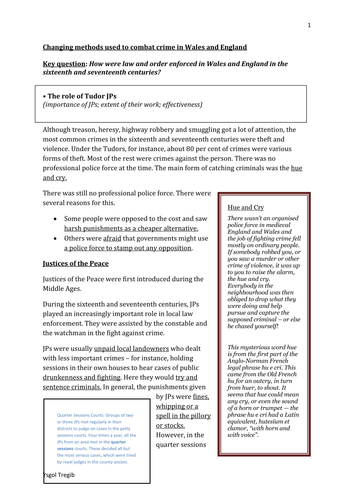
This is for GCSE students of the History of Crime, Policing and Punishment paper. This detailed information booklet covers the POLICING section only. It can be used to accompany the course or as a revision tool.
The specifications followed in the booklet are outlined below:
Key question: How were law and order enforced in Wales and England in the sixteenth and seventeenth centuries?
• The role of Tudor JPs
(importance of JPs; extent of their work; effectiveness)
• The role of constables and watchmen
•(parish constables and the extent of their work; watchmen: their work and their effectiveness)
Key Question: What were the main turning points in policing methods in Wales and England in the late eighteenth and the nineteenth centuries?
• The Bow Street Runners
(the Fielding brothers; establishment of the Runners; importance of the Runners)
The establishment of the Metropolitan Police
(Robert Peel and the 1829 Metropolitan Police Act – reasons and effectiveness)
Extension of police forces and early police specialisation
(The acts of 1835, 1839 and 1856; CID, photography and finger printing)
Key Question: How have policing methods developed in Wales and England in the twentieth and twenty first centuries?
Increased resources for the police
(transport developments; communication and increasing use of technology; training and recruitment changes, including women police)
Specialisation of police services
(development of specialist branches; development of CID, forensics, community relations, crime prevention)
Modern day problems for the police
(police use of weapons; increased powers of arrest and of questioning; pressures of red tape and more organised
criminals)
This is a detailed, colourful booklet with a wide range of sources included.
The specifications followed in the booklet are outlined below:
Key question: How were law and order enforced in Wales and England in the sixteenth and seventeenth centuries?
• The role of Tudor JPs
(importance of JPs; extent of their work; effectiveness)
• The role of constables and watchmen
•(parish constables and the extent of their work; watchmen: their work and their effectiveness)
Key Question: What were the main turning points in policing methods in Wales and England in the late eighteenth and the nineteenth centuries?
• The Bow Street Runners
(the Fielding brothers; establishment of the Runners; importance of the Runners)
The establishment of the Metropolitan Police
(Robert Peel and the 1829 Metropolitan Police Act – reasons and effectiveness)
Extension of police forces and early police specialisation
(The acts of 1835, 1839 and 1856; CID, photography and finger printing)
Key Question: How have policing methods developed in Wales and England in the twentieth and twenty first centuries?
Increased resources for the police
(transport developments; communication and increasing use of technology; training and recruitment changes, including women police)
Specialisation of police services
(development of specialist branches; development of CID, forensics, community relations, crime prevention)
Modern day problems for the police
(police use of weapons; increased powers of arrest and of questioning; pressures of red tape and more organised
criminals)
This is a detailed, colourful booklet with a wide range of sources included.
Get this resource as part of a bundle and save up to 93%
A bundle is a package of resources grouped together to teach a particular topic, or a series of lessons, in one place.
Something went wrong, please try again later.
This resource hasn't been reviewed yet
To ensure quality for our reviews, only customers who have purchased this resource can review it
Report this resourceto let us know if it violates our terms and conditions.
Our customer service team will review your report and will be in touch.
£1.00
